Biolaminin 111 LN (LN111)
Full-length human recombinant laminin-111
Biolaminin 111 is a full-length laminin-111 protein—an essential extracellular matrix component for many cell types in vivo. It has proven particularly effective in supporting the differentiation of functional hepatic and neural cells in a chemically defined and xeno-free culture.
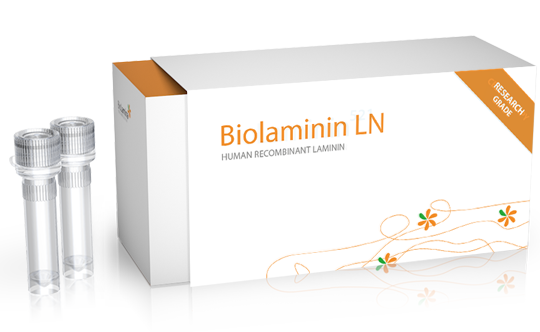
A biologically relevant culture environment
Biolaminin 111 LN (LN111-02 and LN111-0501) supports the survival, proliferation, and differentiation of many different cell types in vitro.
During development, Reichert’s membrane supporting the extraembryonic trophoblasts contains laminin-111. Reichert’s membrane is essential for epiblast differentiation, which is essential for the formation of the three embryonic germ layers by pluripotent cells in the inner cell mass.
In adults, laminin α1 chain is expressed in some epithelial basement membranes, and primarily found in tissues such as the eye, liver, and brain (Ekblom, 2003; Virtanen, 2000). Mimicking the in vivo environment with Biolaminin 111 has proven a viable approach for improved cell growth and identity for several cell types and in various platforms and culture conditions.
Biolaminin®: The only full-length laminin proteins on the market
Learn more about full-length laminins:
The essential component of undefined matrices—chemically defined and full-length
Laminin-111 is the most abundant laminin isoform present in the mouse Engelbreth-Holm-Swarm (EHS) tumor extract sold under the trade name Matrigel. Laminin-111 is known to initiate spontaneous differentiation of stem cells.
By coating your plate with recombinant Biolaminin 111 (LN111) instead of Matrigel or other extract substrates, you support your cells with a defined and animal origin-free substrate. LN111 enables better control of your culture conditions, enhancing reproducibility.
If the goal is to establish efficient self-renewal and expansion of pluripotent stem cells, Biolaminin 521 (human cells) or Biolaminin 511 (mouse cells) should be used. Laminin-521 and laminin-511 are the natural laminins for hES and iPS cells and are proven to maintain pluripotency.
Recommended applications
-
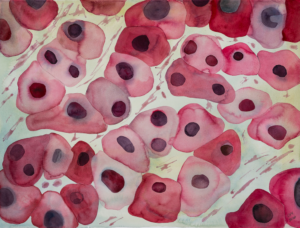
Hepatocytes and hepatoblasts
Biorelevant culture of liver cells on Biolaminin substrates Several laminins play a vital role in liver progenitor cell-mediated regeneration The […]View application -
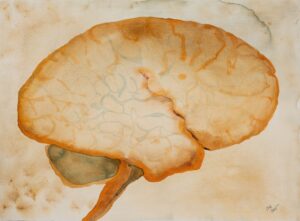
Neural cells
Biorelevant culture of neural cells on Biolaminin substrates Laminins are widely expressed in the nervous system and are essential for […]View application -
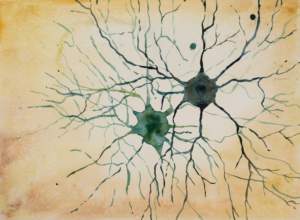
Dopaminergic neurons
Biorelevant culture of dopaminergic neurons on Biolaminin substrates Biolaminin culture supports GMP-compatible differentiation of dopaminergic cells Parkinson’s disease (PD) is […]View application -
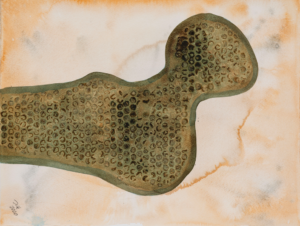
Bone and cartilage cells
Biorelevant culture of bone and cartilage cells on Biolaminin substrates High expression of laminin isoforms in the bone microenvironment Bone cells, including include […]View application -
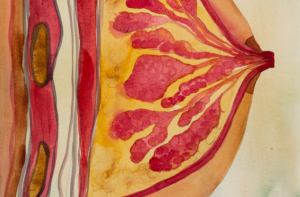
Mammary gland cells
Biorelevant culture of human mammary cells on Biolaminin substrates Laminins have both overlapping and unique functions in the mammary gland tissue Mammary […]View application -
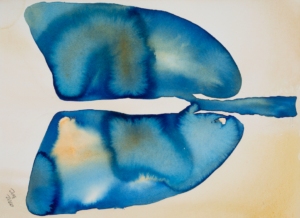
Lung cells
Biorelevant culture of lung cells on Biolaminin substrates Laminin expression in lung Laminin is key proteins in the basement membranes of the airway […]View application -
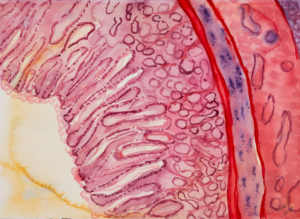
Intestinal cells
Biorelevant culture of intestinal cells on Biolaminin substrates Laminin expression in the intestine The small intestine contains mucosal epithelial invaginations called […]View application
Key features
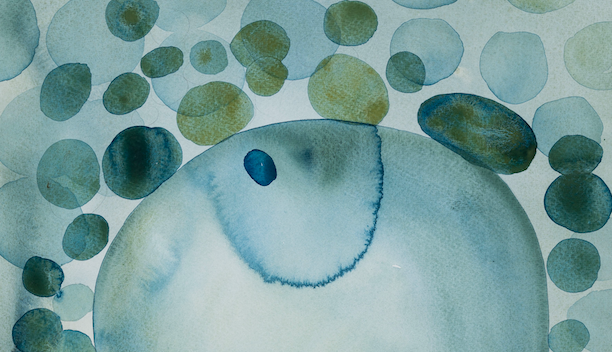
Coating plates
1. Thaw recombinant laminins slowly at +4°C before use.
2. Dilute the thawed laminin stock solution with 1x DPBS.
3. Add the diluted laminin solution to tissue culture-treated surfaces, aiming for a final coating concentration of 0.5-2 µg/cm². The optimal coating concentration may vary depending on the specific cell line.
4. Seal the plate (e.g., with Parafilm®) to prevent evaporation, and incubate at +2°C to +8°C overnight. For faster coating, incubate at +37°C for 2 hours. Ensure the laminin solution is evenly distributed across the surface. Note that the laminin matrix will become inactivated if allowed to dry.
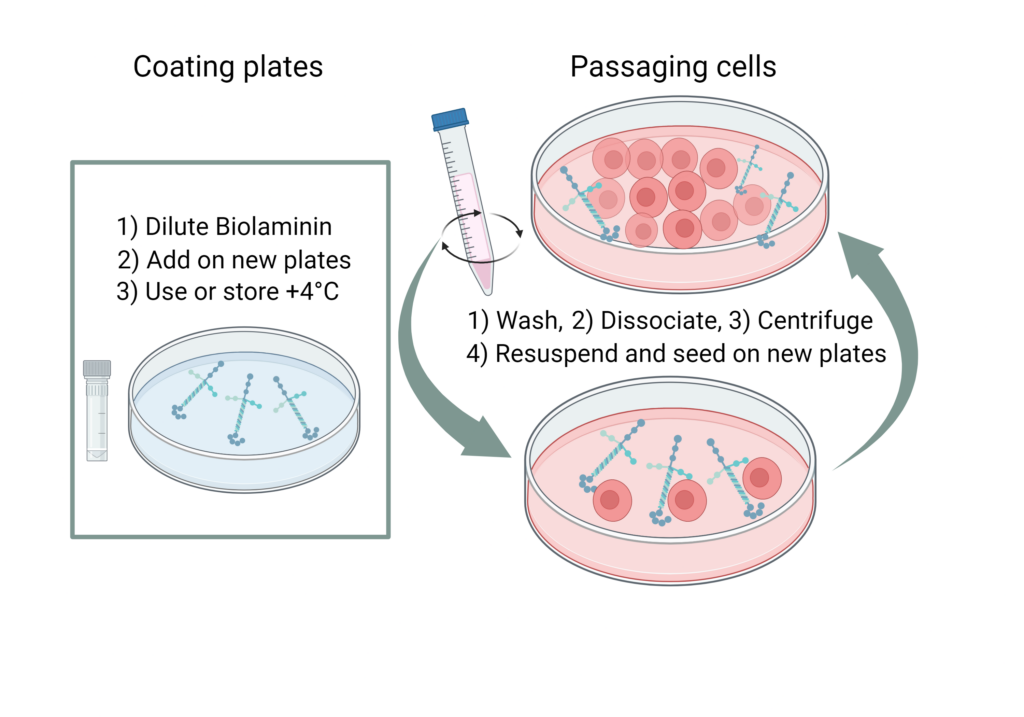
Important notes
Preparation and handling
- Perform all procedures under sterile conditions using aseptic techniques.
- Minimize exposure of the protein to ambient temperatures.
Storage and stability
Laminin stock solution storage
- Store the frozen laminin stock solution at -20°C to -80°C for long-term stability. Refer to the product-specific Certificate of Analysis (CoA) for detailed shelf-life information.
- For long-term storage of thawed stock solution, dispense into working aliquots and store at -30°C to -80°C.
- Avoid repeated freeze-thaw cycles. Thawed, undiluted Biolaminin stock remains stable for 3 months at +2°C to +8°C.
Coated plate storage
Store coated plates aseptically at +2°C to +8°C for up to 4 weeks. Do not let the surface dry.
Troubleshooting Guide
Biolaminin plate coating
An uneven cell spread is often a coating issue and could be caused by the following:
- Low coating concentration: Ensure the laminin coating concentration is high enough to support even cell growth. Increase the concentration if necessary.
- Poor coating coverage or plate drying: Confirm that the entire surface is covered with the laminin coating solution when preparing fresh plates. Avoid drying out the plate, as this will inactivate the laminin. Prolonged time in the incubator or long storage without proper sealing can cause evaporation, leading to localized drying, often in the center of the plate.
Product name
Biolaminin 111 LN
Product code
LN111
Declaration
For research use only
Storage
-20°C to -80°C
Concentration
0.1 mg/ml
Appearance
Clear, colorless, buffered solution with a
pH of 7.2 with 10% glycerol and 0.02% NaN3
Shipping condition
Dry Ice
Protein name
Laminin 111 (Laminin-1)
Classification
Animal origin-free, human recombinant protein
Product application
General cell culture substrate. Expressed and secreted by trophectoderm and some epithelial basement membranes.
Size guide
Not sure how much laminin you need? To make it easy, we have created a tool where you can calculate the amount needed for your experiments. Just choose culture well format and fill in the desired coating concentration to see the amount required.
Please see the coating instructions for concentration and volume guidelines.